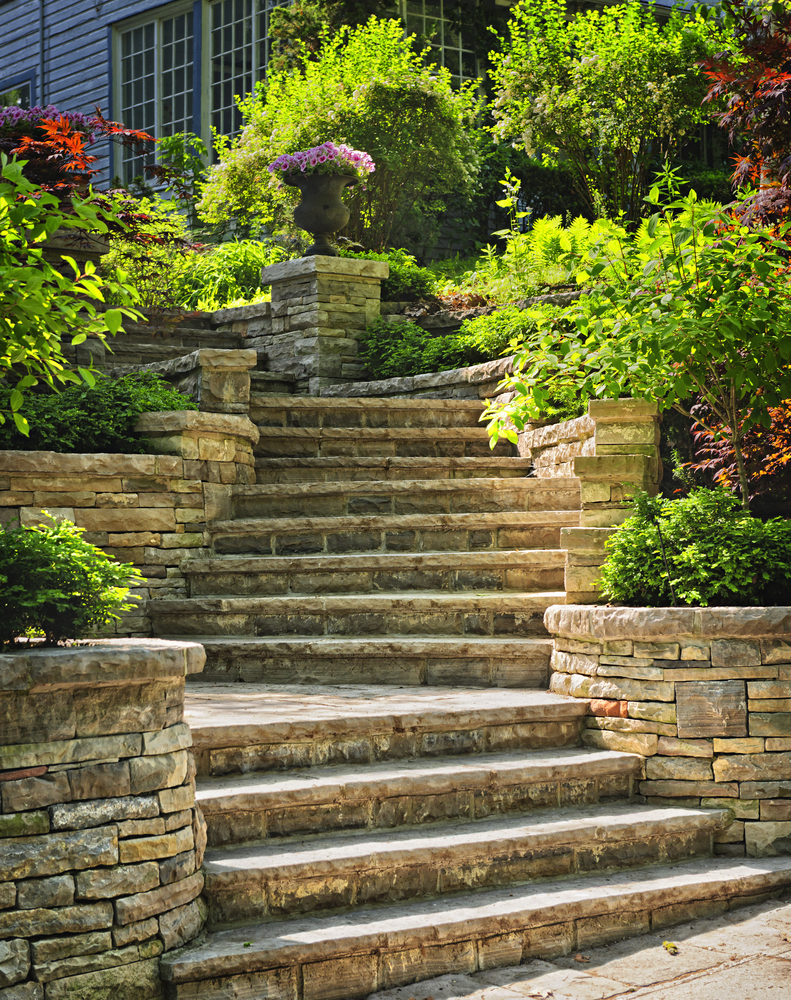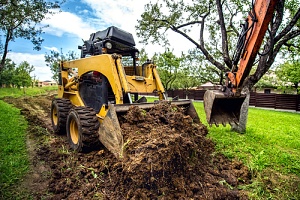After careful consideration, you’ve decided to beautify your home. Landscaping with retaining walls can provide beauty and functionality for entertainment and good times. Suggestions below will provide for the why, types, ideas, themes and the process to complete your new retaining wall improvement project with comments, questions with answers.
One of the best ways to improve your outdoor living space is to add a retaining wall. Retaining walls not only enhance the aesthetics of a yard, they offer protection for the surrounding soil. The walls can inject beautiful stonework and hardscaping to areas and transform your landscaping. The proper placement of the retaining wall will provide improved aesthetics and prevent soil erosion with proper management of rainwater flow.
Why Landscaping with Retaining Walls
- Protect Plants
- Prevent & Manage Erosion
- Improved and Increased Yard Area
- Manage Rainwater Flow
Types
Gravity Retaining Wall
The most basic of retaining walls, the gravity retaining wall uses sheer weight and mass to hold the soil at bay. Bricks, pavers, and unmortared stone are just a few options available, and dry-stacked stone is a very popular choice.
Cantilevered Retaining Wall
Sometimes called a reinforced retaining wall from the steel bars that run through the concrete or masonry retaining wall, the cantilevered retaining walls makes use of a retaining wall affixed to a slab foundation that goes under the soil the wall is supporting in an “L” shape. This style is favored in commercial retaining walls for its strength. A “counter-fort” or “buttressed” retaining wall includes additional vertical wings to the foundation that provides additional strength and rigidity.
Sheet Piling Retaining Wall
Often these have a vertically corrugated structure to provide additional reinforcement. These pilings only work in softer soils, and a good rule of thumb is that you have to get one-third of the sheet piling driven into the ground for every two-thirds that will be above it.
Anchored Retaining Wall
An anchored retaining wall allows for a variety of “fronts” of retaining walls to be supported by anchors driven into the earth behind them and attached by cables or strips. These anchors are usually mechanically driven into the ground and their ends expanded by injecting pressurized concrete or mechanical means. You can use this method to provide additional support to any of the above options and is often used for structurally thinner walls or where higher loads are expected.
Landscaping with Retaining Walls
- Tiered Retaining Walls
- Stairs
- Waterfall
- Boulders
- Serpentine Wall
- Rock Garden
- Timber Walls
- Designated Gathering Area
- Usable Space on a Seemingly Unusable Slope
- Island Flower Bed
- Sitting Wall Around Your Fire Pit or Patio
- Define Spaces in your Outdoor Living Areas or Backyard
- Create Raised Garden Beds or Borders
- Build a Raised Patio
- Turn a Sloping Lawn into a Flat Grass Area
- Combine a Retaining Wall and Water Feature
- Combine a Retaining Wall with a Fire Feature
Retaining Wall Benefits
- Stabilize a Slope
- Improve Erosion
- Manage Water Flow
Insurance
Check with your state on what is required for proper insurance coverage.
Commercial General Liability Insurance
General liability protects against physical injury to people or damage to property arising from your daily operations. Almost every business needs some form of general liability insurance. This protects company assets. Commercial general liability can help small businesses pay for unexpected lawsuits, sign deals with new clients, rent commercial space, and avoid bankruptcy. A Commercial
General Liability (CGL) policy protects your business from financial loss should you be liable for property damage or personal and advertising injury caused by your services, business operations or your employees. It covers non-professional negligent acts. It protects you and your business. Independent contractors have the same legal obligations and liability exposures as larger firms. Damage to client property, bodily injury and harm or advertising injury can occur with independent contractors.
Automobile Liability Insurance
Auto liability insurance coverage helps cover the costs of the other driver’s property and bodily injuries. If you have liability insurance, your insurance provider will cover costs for the driver’s damaged car, minus your deductible, and up to your covered limit. Automobile liability insurance is financial protection for a driver. Financial protection is provided to the driver at fault. Automobile liability insurance only covers injuries or damages to third parties and their property, not to the driver or the driver’s property. The three primary automobile insurances are liability, collision, and comprehensive.
Workers’ Compensation Insurance
Workers’ comp does pay hospital and medical expenses that are necessary to diagnose and treat your job related injury. If unable to work, additional disability payments may apply. Typical payments are about two-thirds of your regular salary.
Step by Step Process for Landscaping with Retaining Walls
Get A Rendering
A sketch of the retaining wall is always a good idea. Make a copy of your plat. With your plat draw the approximate location of the new retaining wall. This will be helpful as you move forward with your project.
Contractor Selection
Your project may require the talents of a professional contractor.
Permit
Your local building permit office issues several different types of permits for construction projects: building permits, trade permits and land disturbance permits. Be sure to check with the permit office for proper building code compliance.
Contact Ms. Utility
Miss Utility is the organization that coordinates the marking of utility lines to prevent them from being damaged by excavation or demolition work.
Excavation
To start your layout, place stakes to represent the location of the front of the retaining wall. You can now paint, mark out the entire length. Excavate the area for the first course. Make sure you get to the frost line. Install and compact the compactable material for the first course.
Wall Installation
Set your first course, straight, level and plumb, then tap each block into place. Repeat this procedure until you reach your desired height.
Drainage
Place the drainpipe at the lowest possible point toward the back of the trench. Make sure the drain line is clear of obstructions for water to run out. I recommend you install filter fabric to the perforated pipe and surrounding #57 stone.
Backfill
Backfill refers to the dirt behind the wall. This backfill material should be tamped into place as applied.
Guard Rail Height
Guard rails must be 36-inch-high, when retaining walls are more than 30 inches off the ground.
Rough Grading
This occurs as you get closer to the completion of your landscaping with retaining wall project. You want to the the slope close and begin picking up and removing the project debris.
Finish Grading
After rough grading, the finish grading can begin. Finish grading is the adding or removing of soil to within 1 – 2 inches of the existing grade. This will create the final contour and elevation of the adjacent ground. This process is important for landscaping with retaining walls.
Ground Cover
With the proper slope and grades complete, you can now add the finishing touches. The placement of seed and straw or sod will provide enhanced aesthetics. These enhanced aesthetics will provide you with the space and comfort you desired.
Lighting
What better way to enjoy the outdoors with improved lighting. Family and friends at the BBQ’s will be highlighted with attractive ambiance of outdoor landscape hardscape lighting.
Quick Installation Overview
- Dig a trench for your base.
- Compact the base area.
- Install the first course level, plumb and straight.
- Level and plumb each course.
- Provide for proper drainage and weep holes.
- Apply proper backfill material.
- Rough grade and preliminary clean up.
- Final grade and clean up.
- Install ground cover, sod or seed and straw.
- Install safety railing if necessary.
- Enjoy your newly completed Landscaping with Retaining Walls
Comments:
Steps
Steps should have a riser of 7″ – 8″ in height and a tread of 12″ – 18″. This will provide for comfort as you walk.
Type of Soils
Different soil types will dictate the type, size and design necessary for the landscaping with retaining wall specifics. Check with your local building department of details.
Vegetation
Properly selected plants will provide additional erosion, water management control and enhanced beauty.
Questions:
What is the easiest retaining wall to build?
Stacked blocks and timber walls are the easiest for the do-it-yourselfer.
Do you need a concrete footing for a retaining wall?
A solid base is a must for a proper retaining wall installation. The type of retaining wall you are building, will determine if you need a concrete footing.
Do I need drainage behind retaining wall?
Yes, always make plans for proper drainage with stone and filter fabric. Be sure to include properly spaced weep holes.
Do I need weep holes in retaining wall?
Weep holes should be installed to release and manage water flow and pressure from the backside of the retaining wall.
What base should I use for a retaining wall?
Compactable fill material is a must for your retaining wall base.
What kind of wood should I use for a retaining wall?
The best kind of lumber for these walls is pressure treated timbers and or railroad ties.
How deep should concrete footings be for a retaining wall?
A concrete footing should be placed at the frost line for your region. Check with your building department for details.
Can railroad ties be used for a retaining wall?
Railroad ties are a great and inexpensive option.
How far apart are weep holes?
Weep holes placed 16 to 24 inches o.c. is a good rule of thumb. Check with your building department of code compliance details.
Enhancing Your Outdoor Space with Retaining Walls
When designing your landscape, incorporating retaining walls can elevate the beauty and functionality of your yard. Retaining walls not only create visual interest but also address practical concerns like soil erosion and rainwater management. By selecting the right type of retaining wall, you can transform slopes into usable space and improve overall aesthetics. For example, tiered retaining walls and boulder arrangements can make sloped areas more functional. Additionally, incorporating features like stairs or a waterfall can add elegance to your outdoor space.





















































